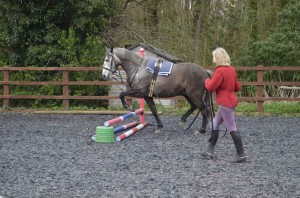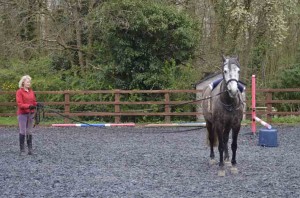Many people ask me why should we long rein? I too, in my past have used a cavasson noseband and a single line to lunge a horse, carrying a whip in my other hand. I was young, I did not know what damage I was doing to the horse. I was introduced to long reining by Tommy Squires,in 1980. He was master of the Sevington Foxhounds in Somerset, a farmer who had spent his life ploughing with horses and bred his own shires and hunters. He long reined all his horses and was about to pass the skill onto me.
It was Monty Roberts who pointed out that the extensive use of the single line lunge for exercise, rather than soley for the training of students is detrimental for the horse.
Why? Well the horse is an ‘into pressure’ animal. When the line puts pressure on the horse’s nose the horse pulls away from it increasing the pressure. if this is done for weeks and months, the horse will displace its atlas vertebra, by constantly pulling its head away from the pressure. So over a period of time it is possible to see if a horse has been single line lunged as exercise. It will immediately hang its head out of the circle.
The whip, is another reason why you should not single line lunge. Not everyone is even tempered. Not everyone is a cool sensible horse person who does not loose their temper when the horse becomes difficult. The whip becomes an instrument of correction and therefore pain.
I have seen many a whip broke horse and many who refuse to single line lunge because they are afraid. Thanks to Monty Roberts’ observation I have adopted a position which is to work extensively on double lines. |Two lines balance a horse and make it possible to train him at every pace and in every way. It is like riding from the ground.
I have been working from the ground with horses now for many years. I have found the process of teaching a horse to behave and accept a trainer from the ground wholly educational, effective and character building, both for the horse and the trainer.

I cannot stress enough that the correct teaching, which I will outline and time are the most important requisites. We should know that it is the good rider/handler who makes the good horse. The following are the qualities that a good rider/handler must develop before training should commence.
- Observation, a rider must learn to use his eyes like that of an artist. Absorbing every detail of the horse’s movement, fitness, communication, eyes, ears, tail, gaits, and gestures. It is important to learn that horses communicate with the subtlest gestures. Each flick, movement, is of significance. So the artist’s eye should be trained to see everything.
- This is essential. You must always follow the same parameters of behavior. Never allow your horse to push you or shove you or step on you or walk past you. NEVER! Not just once or occasionally, or when you are not paying attention. You should always pay attention. You must always make sure that when you make a request of your horse that the horse complies. NEVER hit your horse, NEVER scream or shout, or loose your temper. That will get you exactly nowhere. Always be kind, firm, calm and resolute in your intention. Know that everything you do with your horse trains it. That includes creating bad habits, such as never standing still while being saddled. Or always avoiding the bridle. These problems can be dealt with at a later stage.
- Training as we all know provides a basis of forming good judgments about problems. We become more confident through training. So does the horse! The more you train a horse to read your requests the more confident he becomes. Requests can be fulfilled, quickly and easily. This is what makes a good team, a good horseman and a good horse.
- Without commitment you cannot achieve anything.

When I train a horse on the long reins, I try hard to do the following;
Never ask a horse twice to complete a task, that is called nagging. Do you want a dull horses because if you do constant nagging will get you there. I watch carefully and try to give the right level of request; gentle requests are pertinent for a Thoroughbred because they are often lively, firm and clear requests for the horse that looks a little dull or sad. I measure my requests to suit the student. A horse that has got used to never responding will need careful retraining.
I make sure that I change direction every 4 or 5 turns and always mix up the transitions, walk to halt, halt to back up, walk to trot, halt to trot, trot to canter, walk to canter, as they respond to the voice aids and start to learn from me what I would like them to do.
Mostly horses love to work if you are kind and kindness and affection are an enormously important part of my training program. I always praise when praise is due and my method of praising is to stop halt with loose lines and then walk up to the horse and rub it on the forehead and neck. I find that my affection and genuine praise and love of the horse is transmitted and the horse learns to love this little moment and is always delighted to stand perfectly still and enjoy the moment. You can easily cure a horse that won’t stand still by using this method.

I have horses I have worked with for long periods of time and they will stop as soon as I say “Good Boy/Girl” and wait for a hug and a rub. That is training. I will also take the time out to explain to a horse what I am doing as if I was talking to a child, and although I know they cannot really understand, they seem to respond, they listen and soften. I often wonder just how much they do understand.
My work on the long reins is about making a good and responsive horse. A horse happy in is own skin. Confident to go out there on its own and enjoy the moment of being alone but also attached to me, albeit by the lightness of touch. A horse who thinks and responds and is happy, a horse that I now feel I would like to ride.
It all takes TIME. Time is an essential component in this equation. You can’t achieve anything overnight. Horse training takes years, not minutes. All the horses I work with have owners who are committed to seeing it through to the end result, a nice, safe responsive horse. That is a jewel beyond price. So TIME is important and if you don’t have time then don’t mess with horses.
Train your horse from the ground at least 70% of the time you spend with it and ride it about 30%. That way you will be able to develop the top line muscles, the neck and quarters to a satisfactory level that will allow the horse to carry your weight remaining convex and not straining in a concave outline.
